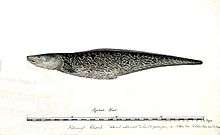Genypterus capensis
Genypterus capensis (Smith, 1847), commonly known as kingklip, is a species of cusk eel occurring along the Southern African coast from Walvis Bay in Namibia to Algoa Bay in South Africa, and is closely related to Genypterus blacodes from New Zealand. The species grows to a maximum length of 180 cm, a weight of 15.0 kg, and is one of the most popular fish items on South African menus. Despite appearances it is not closely related to the eel family of Anguilliformes.
| Genypterus capensis | |
|---|---|
 | |
| Scientific classification | |
| Kingdom: | Animalia |
| Phylum: | Chordata |
| Class: | Actinopterygii |
| Order: | Ophidiiformes |
| Family: | Ophidiidae |
| Genus: | Genypterus |
| Species: | G. capensis |
| Binomial name | |
| Genypterus capensis (Andrew Smith, 1847) | |
| Synonyms | |
| |
Kingklip occur at depths from 50 – 500 m, but usually in the range 250 – 350 m. They are bottom-dwelling and inhabit rocky localities on the shelf and upper continental slope. Juveniles are more often found in shallow waters. They feed on dragonets, mantis shrimps, hake, squid, and various fish species. Spawning usually takes place from August to October. The species is oviparous, with oval pelagic eggs floating in a gelatinous mass. Their dorsal soft rays number 150, while the anal soft rays number 110. The head and body are normally pink to orange in colour, with dark blotches dorsally.
Andrew Smith, the redoubtable Scots explorer and zoologist, first described the kingklip in 1847 from a specimen caught near the entrance to Table Bay and named it Xiphiurus capensis ('xiphos'=sword, 'oura'=tail). His description was published in "Illustrations of the zoology of South Africa", an account of the natural history objects he collected during his expedition into the interior of South Africa in 1834-36. It was also described by the German naturalist Johann Jakob Kaup in 1858 and named Hoplophycis lalandi.[1]
Kingklip were heavily exploited in the 1980s, and populations have not yet recovered so that some precautions are in place. Being relatively slow-growing and long-lived, stocks cannot sustain the pressure of targeted fishing, and are taken only as a bycatch species. It is one of the economically important species to South African fisheries. The related species from New Zealand, Genypterus blacodes, has made its way to South African markets and is retailed as kingklip. Kingklip's lack of obvious scales has sparked lively and ongoing debate in Jewish circles as to whether it qualifies as kosher or treif.[2]
The South African Journal of Marine Science, in Volume 8, Issue 1 of 1989, published a description of the species' larval development in the southern Benguela Current. The distribution of kingklip larvae was studied over a 12-month period, and yielded data on spawning areas and breeding seasons. The researchers concluded that there are different spawning strategies for the western Agulhas Bank and the West Coast. On the Agulhas Bank, spawning is initiated by a decrease in sea surface temperature, whereas on the West Coast, spawning only occurs when upwelling has decreased i.e. between June and December.[3] Females grow larger than males in both areas, but are slower growing.[4]
'Genypterus' is derived from 'genyos' = face, jaw and 'pteron' = wing, fin [5]
References
- Fishwise
- Cook, Julia. "On Scale of Probabilities, Kingklip Should Be Kosher". UOS. Union of Orthodox Synagogues. Retrieved 9 September 2019.
- "Early life history and spawning ofGenypterus capensis(Smith, 1849) in the southern Benguela system". South African Journal of Marine Science. 8: 173–181. doi:10.2989/02577618909504559.
- "A new study on age and growth of kingklipGenypterus capensisoff the south and west coasts of South Africa, with comments on its use for stock identification". South African Journal of Marine Science. 9: 223–237. doi:10.2989/025776190784378754.
- FishBase
- Nielsen, J.G., D.M. Cohen, D.F. Markle and C.R. Robins. 1999. (Ref. 34024)